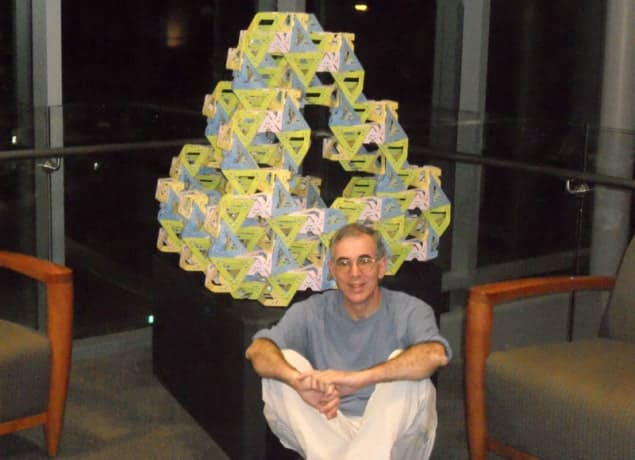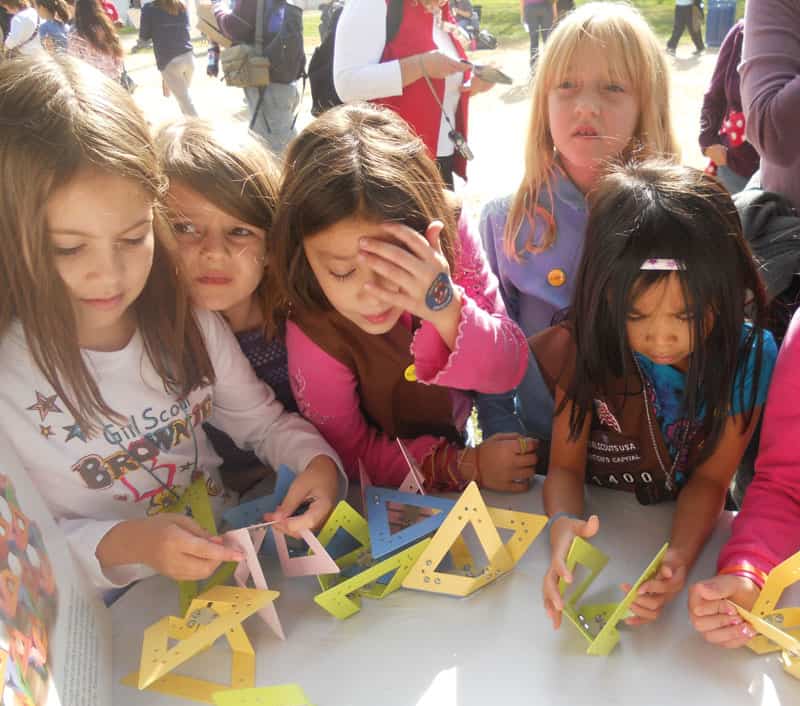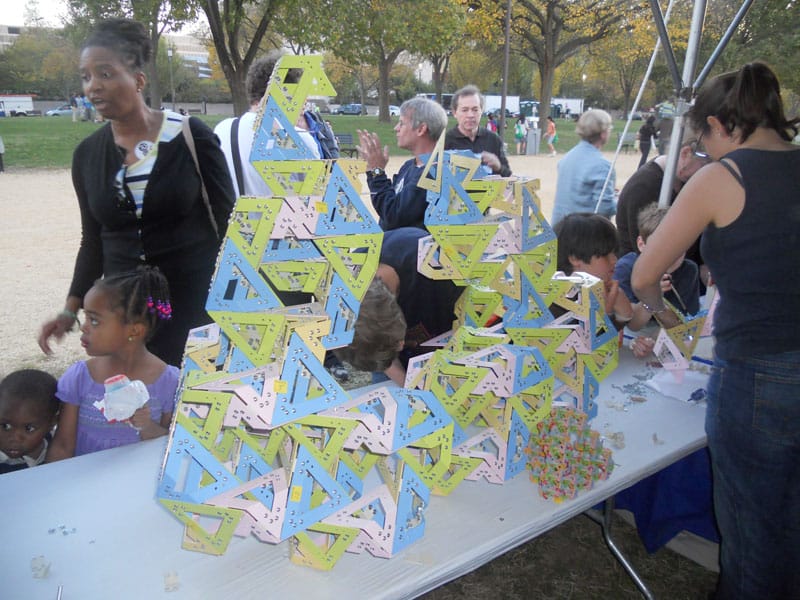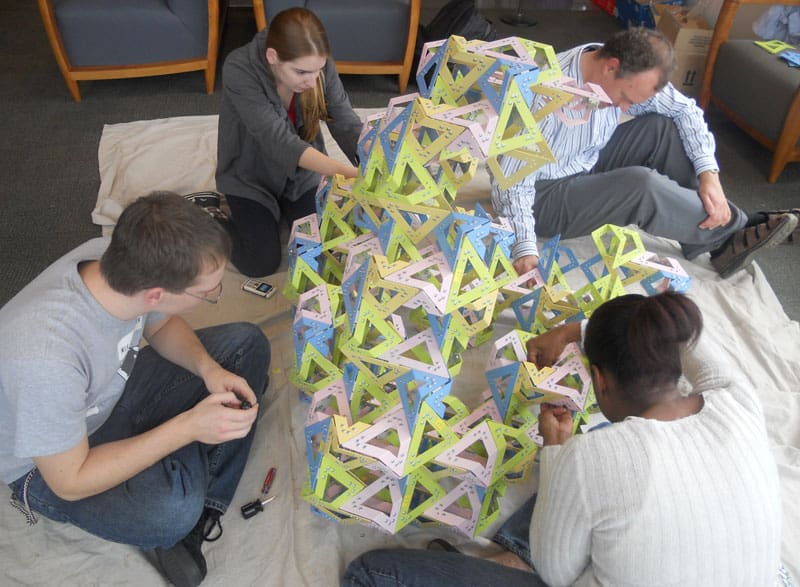An exotic structure made of 490 hollowed-out triangles recently enthralled the hundreds of members of the US public who assembled it. Robert P Crease explains why

One warm and sunny weekend last October, tens of thousands of people congregated on the National Mall in Washington, DC – not for a political rally or protest, but to attend the first ever US Science and Engineering Festival. Laid out along the two-mile stretch between Capitol Hill and the Washington Monument were more than 1500 interactive scientific exhibits. The festive air was enhanced by stage shows and performances by comedians, magicians and musicians.
One of the most popular exhibits was a sculpture called Gyrangle, commissioned and sponsored by the American Mathematical Society (AMS). Swarms of children and adults helped to assemble the sculpture, designed by the computer engineer and artist (and my former Stony Brook colleague) George W Hart, who was on hand to supervise the volunteers. Just over a metre high, Gyrangle consists of 490 triangular pieces of laser-cut steel, each about 15 cm on a side.
Cool ideas
Hart, who is now “chief of content” for the recently founded Museum of Mathematics that will open in New York City in 2012, is internationally known for his pioneering applications of mathematics and computer engineering to sculpture. His books include Zome Geometry – a guide to creating structures in 3D space – and also the online Encyclopaedia of Polyhedra. Gyrangle is just the latest structure that Hart has designed specifically to be assembled by groups of people at events that he calls “barn raisings” and that are staged all over the world.
The sculptures typically involve simple shapes combined in simple ways to create highly complex mathematical structures. Gyrangle – which can be seen on Hart’s website at www.georgehart.com/DC – is a name he invented himself. “The structure is based on a minimal surface called a ‘gyroid’, which I put together with ‘triangle’,” Hart told me on the first day of the festival. “A gyroid is like the surface of a twisty soap bubble. A few years ago I discovered an approximation to the surface using triangles, which I thought was really cool. But instead of publishing a paper I thought I’d make a sculpture using it.”
The event in the National Mall was therefore the first public presentation showing how a gyroid surface can be made from triangles. Part of Hart’s inspiration comes from the Dutch graphic artist M C Escher, who once created a lithograph called Planaria (i.e. flatworms) that shows how octahedral and tetrahedral shapes can be put together in wonderful ways. “[Escher] really knew how to pack space – his brother was a crystallographer,” says Hart. “Gyrangle is another artistic application of that.”
The 490 triangular steel pieces that make up Gyrangle each have a hollow interior; about half are flat and half have a 109.5° fold. The two triangle shapes come in four colours, thus creating a total of eight basic elements. These triangles were then fastened together with simple brackets and screws, using screwdrivers that were liberally scattered around the AMS booth. Four screws attached each bracket to two triangles in one of three dihedral angles: planar, tetrahedral and octahedral. Each pair of triangles attached to several other pairs to create a “submodule”, with submodules being combined to make modules, and dozens of modules comprising the final structure.
Gyrangle is in fact based on a (10,3)-a lattice – or, more accurately, on a cubic section of it made from hollow triangles. (A full description of the lattice was published in 2008 in Angewandte Chemie International Edition (47 7996).) The point of hollowing out the triangles is to see into the structure and its axes, and animations on Hart’s website display the different patterns revealed depending on whether a viewer is looking in the direction of the 2-, 3- or 4-fold axis of the lattice. The website also shows how to create the lattice from ball-and-stick Zome tools or from paper triangles.
Young children tended to spend about 10–15 minutes at the AMS booth. Deeksha, an eight year old from Maryland, put in four screws to connect two triangles, was delighted at her accomplishment, then moved to another booth. Teens tended to spend more time. Samantha, a 15-year-old junior-high-school student, was intrigued by the overall structure. She built a submodule out of eight pieces, then another identical one. “I wanted to put them together in two different ways to see which way was best,” she told me after spending half an hour at the booth. “I found the holes lined up better when you put the greens and yellows together first, rather than begin by making the flat blue plates parallel. But I’m coming back tomorrow to see the whole thing.”
By Sunday evening on the last day of the fair Gyrangle was still not entirely finished, even with the labour of hundreds of participants. Hart therefore took it to nearby Towson University, where the following day students and faculty members helped him complete it, and he gave a talk about its mathematical properties. The AMS then donated it to Towson’s mathematics department.
The critical point
Gyrangle is what I call a “deep object” in that it fulfils the ancient requirement that beauty be the appearance of the abstract and ideal in the realm of the visible. The more it draws you in, the more it delivers back in return. While younger children are content with putting together two of its parts by hand – finding satisfaction from the quick pleasure of completing a small part – older children and adults are drawn in by the sculpture’s design and construction, appreciating its elegance and patterns, and recognizing more levels of complexity than they anticipated. Quite simply, the Gyrangle barn raising is a great example of successful hands-on science.






